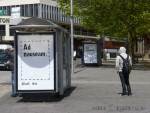The relationship between art and advertising has often been a complicated and tense affair. Some would argue that advertising is just a form of art designed to sell things. Indeed, in Britain, advertising and marketing are bunched together with the arts and considered part of the ‘creative industries’. Advertising has long been a way for artists to earn a bit of cash – even the supposedly ‘anti-consumerist’ street artist Shepard Fairey has been enlisted to do advertising for the likes of Pepsi and Saks, a luxury department store. The campaign of the latter somewhat ironically declared ‘Want It!’.
But aside from the cosy relationship enjoyed by some artists and big brands, there is a definite antagonism between the worlds of art and advertising. Advertising has long harvested cultural images and repurposed them for its own unscrupulous purposes. One particularly crass recent example saw Michelango’s David used by US-based arms firm ArmaLite to sell an automatic rifle, causing outrage in Florence.
In what is often something of a David and Goliath tale in terms of resources, art – street art in particular – can and does strike back with a vengeance. In its relatively brief history, modern street art has been replete with work that directly attacks brands and their marketing images, often appropriating a large company’s logo and using its power and reach to turn it back against them.
More comment from the Muse Room…
In May of this year, the Brandalism project took over 365 advertising spots across 10 British cities and replaced their images with the work of street artists from across the world. Many of the works engaged directly with the pernicious nature of advertising; almost all are critical of consumerist culture more generally. One piece read ‘The large print giveth…the small print taketh away’, whilst another simply said ‘Ad Nauseam. Want less’. Brandalism is a bold, visually striking and highly provocative project, which aims to wrest control of our visual landscape from the big brands.
 In a less openly aggressive way, the ‘Art Everywhere’ project has sought to do something similar, but on a bigger scale, taking over 30,000 advertising spaces and filling them with great works of art as voted for by the public. As I remarked in a piece about last year’s ‘Art Everywhere’, whilst it was welcome to see public space reclaimed from advertising, the artworks were often drowned out by the sea of more eye-catching adverts that surrounded them.
In a less openly aggressive way, the ‘Art Everywhere’ project has sought to do something similar, but on a bigger scale, taking over 30,000 advertising spaces and filling them with great works of art as voted for by the public. As I remarked in a piece about last year’s ‘Art Everywhere’, whilst it was welcome to see public space reclaimed from advertising, the artworks were often drowned out by the sea of more eye-catching adverts that surrounded them.
The antagonism between art and advertising isn’t just about a power struggle over the meanings inscribed on certain images; it’s a battle over our public spaces. Street art and public art must compete for our attention against the tide of adverts. These days almost no space is left unbranded, each of us literally see thousands of adverts a day. Projects like ‘Art Everywhere’ and Brandalism are attempting to redress the balance a little but it’s still highly skewed. Not content with using billboards, buses, mobile phones and even bathrooms to advertise, Morrisons recently went one better by projecting an advert onto a beloved piece of public art, the Angel of the North. The outrage that followed and Morrisons’ hasty public apology showed which side the public seem to be on in this war over our public spaces.
Related Articles
A good advert for American art? Art Everywhere in the US (Louise Nicholson)
Art Everywhere: which works will fare best on the billboards? (Maggie Gray)
Advert Averse: Anger as Morrisons turns the Angel of the North into a billboard (Maggie Gray)





